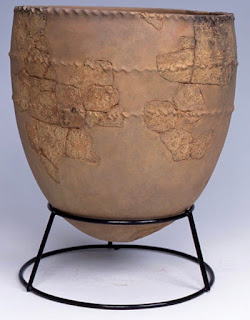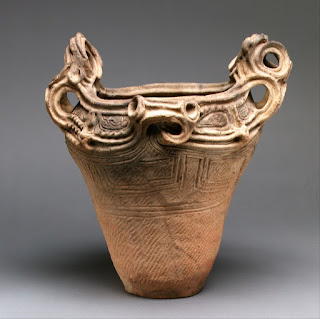The Right Cooking Tools
 |
| An Incipient Jomon pot from Kubodera-Minami, Niigata Prefecture, Japan, about 15,000 years old housed at the Tokamchi City Museum (photo courtesy of Science News) |
To properly cook Jomon recipes, why not make your seafood stew in a typical Jomon cooking vessel? The earliest known Jomon pottery was found at the site of Odai Yamamoto in the Aomori Prefecture. The potsherds from the site date to about 16,500 years ago during the Incipient Jomon period. Archaeologists were able to reconstruct the sherds to reveal a conical-shaped vessel designed to nestle into a fire. Some of the pottery recovered at the site had square-shaped bases, perhaps intended to sit in a stand or possibly for use as storage containers. The pottery was decorated with comb designs made from bone or wood implements as well as impressed decorations made from a stamp or a thumbprint. The sherds were made of horse clay with a temper (an additive made from stone, shell, or straw) added to it to help the clay bind together, especially when it was heated, usually in a low-fired bonfire or pit.
Although the Jamon people were considered hunter-gatherers, they still practiced a sedentary lifestyle and would have used and produced pottery in their permanent base camps. While the invention of pottery is generally associated with the development of agriculture during the Neolithic period and the transition to farming, it is now known through archaeological excavations and analysis that pottery was made by these groups since the end of the last Ice Age.
 |
| Seaweed in a clay cooking vessel from the site of Kamegaoka (Photo from Facts and Details website) |
During the Middle Jomon Period around 5,000 to 7,000 years ago, Jomon pottery began to get really elaborate. The pots were highly decorated with geometric designs, often using ropes or cordage to produce the designs. The name Jomon means "cord marked' that defines much of the pottery of Jomon culture. The pots were decorated with elaborate rims that resembled a flickering fire. Each pot is unique with non-repeating and asymmetrical whimsical designs.
 |
| Flame-rimed bowl from the Middle Jomon Period (Photo from The Met Museum) |
Below is a video of how to make a Jomon coil pot. No potter's wheel needed.
"Jomon Pottery" video retrieved from YouTube and posted by Museum Kiyose
Comments
Post a Comment